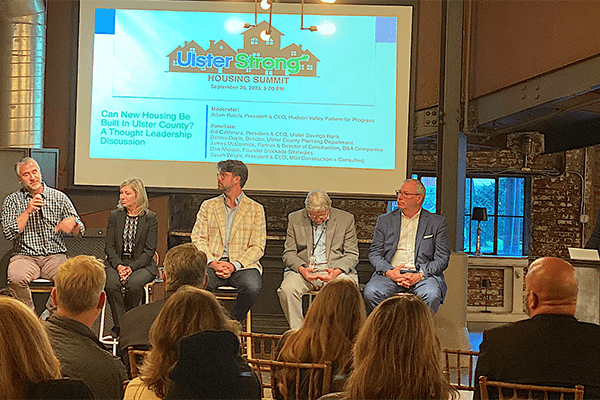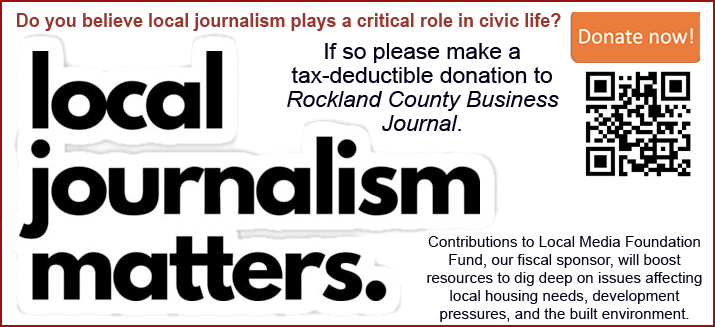|
RCBJ-Audible (Listen For Free)
|
A Division of Hudson Valley Economic Development Corporation (HVEDC) Is Bringing Focused Voices To The Planning Board Process
By Tina Traster
Last October, Kingston’s Mayor Steve Noble issued a public statement expressing delight over the city’s site plan approval for the Kingstonian project, which took nearly eight years.
A soupcon of credit may belong to advocacy efforts on the part of a relatively new pro-business group known as Ulster Strong, which came out to support the proposed $52 million mixed-use development project in Uptown Kingston on the corner of Fair and North Front streets.
“Before Ulster Strong, we did not have an entity that was looking to help with smart growth of the county,” said Bill Calderara, president and CEO of Ulster Savings Bank.
For years, JM Development Group LLC, in partnership with Herzog Supply Co., struggled to secure approvals needed to redevelop a 2.5-acre tract that sits at the heart of Uptown, which has become a hot, hipster destination with new hotels, restaurants, bars, and very-Brooklynesque boutiques. What Dan Ahouse, president at the Kingston-based Stockade Strategies LLC, and others noticed was that this was a project that had great potential to continue the momentum of the ongoing revival of Uptown but opposition was fierce and successful in delaying approvals. The developers’ plan was to pull together retail, restaurant, 142 residential units with 10 percent allocated to affordable workforce housing, and a 32-room boutique hotel. Additionally, the project includes a 420-space parking structure with 250 spaces devoted to city parking.
Ahouse, whose company Stockade Strategies specializes in government affairs and community development, began huddling with Mike Oates, president of Hudson Valley Economic Development Corporation, an economic development organization for the Hudson Valley, New York region including seven counties: Dutchess, Orange, Putnam, Rockland, Sullivan, Ulster, and Westchester. The pair began to think about what it would look like to create a division of HVEDC to focus on hyper local development and economic issues, and to steer advocacy campaigns for what they believed to be sensible projects for smart growth in the Hudson Valley.
Nearly two years later, Ulster Strong has designed a template that combines advocacy, education, and networking for local and regional businesses that share common goals.
“Ulster Strong was born out of multiple conversations among stakeholders in Ulster County who were watching with interest the review and approval process of the Kingstonian,” said Ahouse, an Ulster Strong board member.
What Ahouse noticed was that planning and zoning meetings were filled with opponents of the project but no one was speaking on behalf of the business community that favored it. The strategist noted that groups opposing development have become adept at organizing and spreading their message. “I was thinking about my experiences organizing political campaigns and my understanding of activists,” said Ahouse, adding that what became clear was the business community needed to employ similar grassroots tactics to have a voice when projects are navigating through the planning and zoning board stages.
“Up here in Ulster County, there are many community and grassroots organizations that organize, recruit, and mobilize, and I was thinking why not have an organization that is pro economic development do the same?” he added.
Ulster Strong is a division of HVEDC but it has its own Executive Board, two part-time consultants, and about 30 dues-paying members. (The organization does not publish its members’ rates). Among its stated goals are to mobilize the public to become active participants in project review processes, educate the public about the community benefits of smart growth projects, provide balance to public discourse on economic development issues, and act as a resource for investment and development prospects.
“Ulster Strong is a vision of HVEDC but its sole focus is Ulster,” said Oates. “Dan and I were talking about the Kingstonian project and what we were hearing from business leaders was that they were frustrated with that project and others that do not get enough support during planning board meetings. Through conversations with business leaders over more than a year, we put this into action.”
Ulster Strong has also made the proposed development of Winston Farm in Saugerties a target of its efforts. The controversial plan calls for developing a largely forested 815-acre parcel just off exit 20 from the Thruway, known as the “gateway to the Catskills,” and is probably most famous for hosting the Woodstock ’94 concert. The proposal calls for a mixed-use destination venue including 272 acres of low-density residential and 74 acres of high-density residential, an indoor waterpark and hotel, an amphitheater, and a tech and business park, among other features.
“We were emerging when the Winston project started their process and seeing blanket opposition,” said Ahouse. “We began to go to public meetings and get supporters to show up, sharing information and communicating with the public using social media, and a growing email list.” Ulster Strong also has a monthly newsletter it disseminates to members.
“We were building a communication mechanism, getting organized, using that kind of infrastructure,” he added.
Sometimes, Ulster Strong comes out to oppose a project, such as a proposed asphalt project on Route 28 in Kingston. That advocacy ultimately didn’t work; the applicant prevailed.
Ulster Strong also wants to play a role in thought-leadership and streamlining the planning processes. Last September the organization hosted the first of its Thought Leadership Series “Ulster Strong Housing Summit: Can New Housing Be Built In Ulster County?” The panel was moderated by Adam Bosch, President and CEO of Pattern for Progress, which has recently released the report “Out of Reach” outlining the current housing affordability crises. Pattern plans to make housing shortages a focus of its research in 2024.
It will take stamina and perseverance to make an organization like Ulster Strong stand the test of time. Development projects typically stretch over years and those who oppose them are usually motivated and focused. At the Ulster Strong Housing Summit panel, Susan Wright of MGI Construction & Consulting, said there was a need for developers to do a better job of community engagement and education.
“There are many people who just operate out of fear….fear of who will be in my backyard,” said Wright. “And I think a lot of it could be addressed by education.”
The Kingstonian project still has legal hurdles to clear but the Kingston Mayor has said, “The Kingstonian project is one of the most studied and involved community-input processes we’ve ever had, and I believe the project has improved through each step in its evolution.”
Ahouse and Oates both say the template Ulster Strong has created can be replicated in any county, or even a city or village. Initial talks on organizing a Rockland Strong were started in 2023 and Oates says those talks are ongoing.
For members, Ulster Strong has become an opportunity to sit at the table.
“Before Ulster Strong, we did not have an entity that was looking to help with smart growth of the county,” said Bill Calderara, president and CEO of Ulster Savings Bank, a member. “When it comes to economic development, we want to be part of the conversation. We want to be more proactive rather than reactive. We want to help planners and officials sharpen their views on smart development.”











